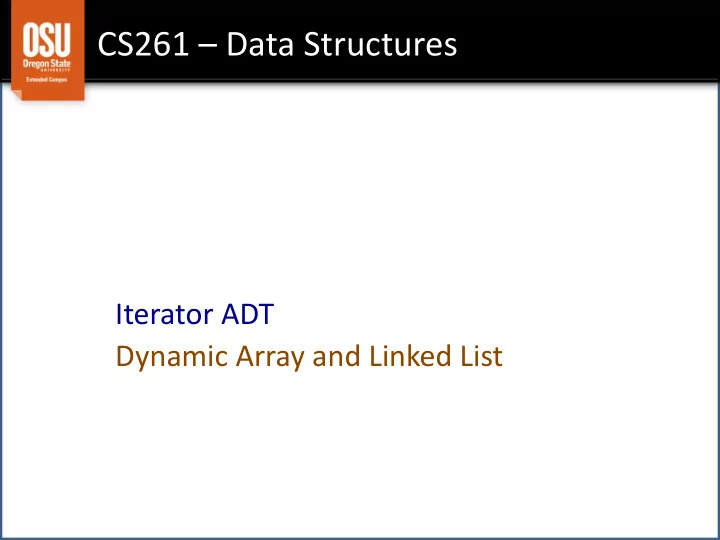

CS261 – Data Structures Iterator ADT Dynamic Array and Linked List
Goals • Why do we need iterators? • Iterator ADT • Linked List and Dynamic Array Iterators – The lecture will focus on link list iterators
Interface of Bag ADT void initBag (struct Bag *da, int cap); void freeBag (struct Bag *da); void addBag (struct Bag *da, TYPE val); int containsBag (struct Bag *da, TYPE val); void removeBag (struct Bag *da, TYPE val); int sizeBag (struct Bag *da); What if the user wants to loop through the bag to print out of filter contents?
Iterator Concept • Problem: How do you provide a user of a container access to the elements, without exposing the inner structure? • Think of two developers: one writing the container (that’s you!!!) , the other using the container (that’s someone using your library to build an application where they need, for example, a stack implementation)
Traversing a Container – as Developer For example, within the Linked List container you (the developer) wrote a loop such as the following: struct LinkedList *list; struct Link *l; ... /* Initialize list. */ l = list->frontSentinel->next; while(l!=list->backSentinel){ …do something… l=l->next; } This is fine within the container library code itself, but we don ’ t want users of the container library to have to know about links…or worse yet, be able to manipulate links!
Encapsulation • Chapter 5: Hide the implementation details behind a simple and easy to remember interface (ie. abstraction mechanism) • Users should not know about links, arrays, size, capacity, etc. • Users should know and use the public abstractions: push, pop, contains, remove, etc.
How do we abstract away loops… for(i = 0; i < sizeDynArr; i++) val = getDynArr(i); while( cur != backSent) do something cur = cur -> next do { something cur = cur->next; }while (cur != backSent);
Iterator ADT Solution: define an interface that provides methods for writing loops int hasNextIter(struct Iter *itr); TYPE nextIter(struct Iter *itr); void removeIter(struct Iter *itr); void changeIter(struct Iter *itr, TYPE val); void addIter(struct Iter *itr, TYPE val);
Iterator: Typical Usage TYPE cur; /* current collection val */ struct linkedList *list; linkedListIterator *itr; list = createLinkedList (…) itr = createLinkedListIter(list) while (hasNextListIter(itr)) { cur = nextListIter(itr); if (cur ...) removeListIter(itr); }
LinkedListIterator struct linkedListIterator { struct linkedList *lst; struct dlink *currentLink; } struct linkedListIterator *createLinkedListIterator ( struct linkedList *lst) { struct linkedListIterator *itr; itr = malloc(sizeof(struct linkedListIterator)); itr->lst = lst; itr->currentLink = lst->frontSentinel; return itr; }
After Initialization Itr list current backSent List frontSent prev prev prev prev prev … Link Link next next next next next front
Strategy • HasNext – Returns T (F) to the user if there is (is not) another value remaining to be enumerated • Next – Return the next value to be enumerated and updates current to point to that value (assumes HasNext was called and returned T) • Remove – Removes the value (and link) that was last returned by call to Next() NOTE: Some designs will use HasNext to update the current and Next just returns current.
After Initialization while (hasNextListIter(itr)) { curVal = nextListIter(itr); … } Itr list current backSent List frontSent prev prev prev prev prev … Link Link next next next next next front
After One Iteration:hasNext, next while (hasNextListIter(itr)) { curVal = nextListIter(itr); … } Itr list current backSent List frontSent prev prev prev prev prev 5 10 15 next next next next next front
After Two Iterations while (hasNextListIter(itr)) { curVal = nextListIter(itr); … } Itr list current backSent List frontSent prev prev prev prev prev 5 10 15 next next next next next front
After Three Iterations while (hasNextListIter(itr)) { curVal = nextListIter(itr); … } Itr list We’ve enumerated all elements current Subsequent calls to HasNext will evaluate to false backSent List frontSent prev prev prev prev prev 5 10 15 next next next next next front
After Two Iterations – then Remove Remove the last value enumerated (10) Where should current be after the removal? Itr list while (hasNextListIter(itr)) { curVal = nextListIter(itr); if(curVal == 10) current removeListIter(itr); } backSent List frontSent prev prev prev prev prev 5 10 15 next next next next next front
After Two Iterations – then Remove Remove the last value enumerated (10) Where should current be after the removal? Itr list current backSent List frontSent prev prev prev prev 5 15 next next next next front
Your Turn Worksheet#24 Linked List Iterator
Is there another element? // Return T (F) if there is (is not) a next element int hasNextListIter (struct linkedListIterator *itr) { return itr->currentLink->next != itr->lst->backSentinel; } struct linkedListIterator { struct linkdList *lst; struct DLink *currentLink; }
Return and update the next element /* Returns next element and updates that element to be the current element */ TYPE nextListIter (struct LinkedlistIterator *itr) { itr->currentLink = itr->currentLink->next; return itr->currentLink->value; } struct linkedListIterator { struct linkdList *lst; struct DLink *currentLink; }
Remove an Element (the most recent one returned by next) Assume you have following function: // removes lnk from the list it is part of void _removeLink (struct DLink *lnk) void removeIter (struct listIter *itr) { itr->currentLink = itr->currentLink->prev; _removeLink(itr->currentLink->next); } struct linkedListIterator { struct linkdList *lst; struct DLink *currentLink; }
Remove Link void _removeLink (struct dlink *lnk) { } db backSentinel prev prev prev prev Link lnk Link next next next next frontSentinel
Worksheet 24 void _removeLink (struct DLink *lst) { lnk->prev->next = lnk->next; } db backSentinel prev prev prev prev Link lnk Link next next next next frontSentinel
Worksheet 24 void _removeLink (struct DLink *lst) { lnk->prev->next = lnk->next; lnk->next->prev = lnk->prev; } db backSentinel prev prev prev prev Link lnk Link next next next next frontSentinel
Worksheet 24 void _removeLink (struct linkedList *lst) { lnk->prev->next = lnk->next; lnk->next->prev = lnk->prev; free(lnk); } db backSentinel prev prev prev Link Link next next next frontSentinel
Recommend
More recommend